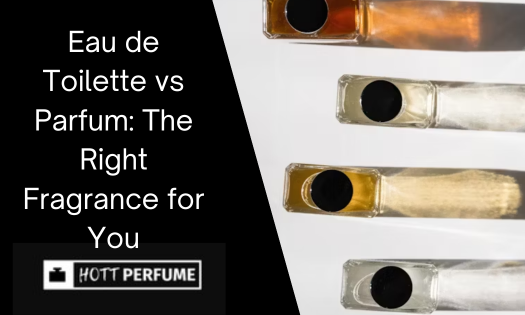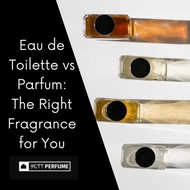Eau de Toilette vs Parfum: Choosing the Right One
Posted by Tina Wilson on Aug 5th 2025

Introduction to Fragrance Types
Understanding the distinctions between eau de toilette, eau de parfum, and parfum, especially regarding their higher intensity, is crucial when selecting the right fragrance for your needs, ensuring you have the right concentration for your preference. These fragrance types differ primarily in their concentration of fragrance oils, which directly impacts the scent’s intensity and how long it lasts on the skin.
Eau de parfum and eau de toilette, along with cologne, are among the most popular fragrance types, commonly chosen for both everyday wear and special occasions. The concentration of fragrance notes in each type, which reflects different concentrations, influences not only the strength of the scent but also its longevity throughout the day. Perfume oils and the overall fragrance concentration play a significant role in determining which fragrance suits individual preferences best, whether you desire a subtle, refreshing aroma or a rich,long-lasting scent.
Concentration of Fragrance Notes
Fragrance concentration is a key factor that influences the strength, longevity, and suitability of a perfume for different occasions. Understanding these differences, particularly the main difference between fragrance types and other fragrance types , helps you select the right fragrance type to match your preferences and lifestyle. Here’s a detailed breakdown:
-
Eau de Parfum (EDP) Concentration:
Contains approximately 15% to 20% fragrance oils. This higher concentration results in a richer, more intense scent that tends to last longer on the skin—typically around 4 to 8 hours or more. EDPs are ideal for evening wear, special occasions, or when you want a more pronounced fragrance presence. -
Eau de Toilette (EDT) Concentration:
Contains about 5% to 15% fragrance oils, making it lighter and more subtle than EDP. EDTs usually last around 3 to 5 hours, making them well-suited for daytime use, casual settings, or warmer weather when a lighter scent is preferred. -
Impact on Intensity:
The higher the concentration of fragrance oils, the more intense and noticeable the scent will be. EDPs offer a deeper, more complex aroma, while EDTs provide a fresher, more delicate fragrance experience. -
Longevity Differences:
Due to the concentration of oils, EDPs generally have greater staying power, requiring fewer reapplications throughout the day. EDTs may need to be reapplied more frequently to maintain their scent. -
Suitability for Occasions:
EDPs are often chosen for formal events, evenings out, or cooler seasons when a stronger scent is desirable. EDTs are preferred for everyday wear, office environments, or warmer climates where a lighter fragrance is more comfortable. For a direct comparison of popular fragrances, see Dior Sauvage EDT vs EDP.
By understanding these concentration differences, you can better choose a fragrance that fits your personal style, occasion, and desired scent intensity, such as eau de toilette for lighter options.
Characteristics of Eau de Parfum
Eau de parfum is favored for its richness and longevity, offering a more intense fragrance experience compared to lighter scent types like eau de cologne . Here are its key characteristics:
-
Richer, Longer-Lasting Scent: Contains a higher concentration of fragrance oils, resulting in a scent that lasts longer throughout the day.
-
More Intense Olfactory Experience: The elevated oil content creates a deeper, more complex aroma.
-
Versatile Usage: Suitable for evening wear, special occasions, and cooler climates where a stronger scent is preferred.
-
Potent and Full-Bodied: The fragrance is robust and enveloping, providing a noticeable presence.
-
Leaves a Lasting Impression: Designed to linger on the skin, making it ideal for those who want their scent to be memorable.
These qualities make eau de parfum a popular choice for those seeking a sophisticated and enduring fragrance, unlike those with lower concentration .
Eau de Toilette and De Toilette
|
Feature |
Description |
|---|---|
|
Fragrance Intensity |
Lighter and more subtle compared to eau de parfum. |
|
Suitable Occasions |
Ideal for everyday wear, daytime use, and casual occasions. |
|
Longevity |
Requires more frequent reapplication due to lower concentration of fragrance oils. |
|
Terminology |
"De toilette" is another term for eau de toilette, highlighting its lighter, fresher scent. |
|
Ideal For |
Perfect for those who prefer a subtle, refreshing fragrance that is easy to wear daily. |
Choosing the Right Fragrance
Selecting the perfect fragrance involves considering personal preferences, the occasion, and your skin type. Eau de parfum and eau de toilette offer different scent intensities and longevity, catering to varied needs and tastes. When choosing, pay attention to the concentration of fragrance oils, as this affects how long the scent lasts and its overall intensity.
Testing fragrances on your skin is crucial, as body chemistry can influence how a scent develops and smells on you. Ultimately, finding the real difference in concentrations of fragrance oils ensures a satisfying and enjoyable fragrance experience tailored to you.
Parfum and Its Uses
|
Feature |
Description |
|---|---|
|
Concentration |
Highest concentration of fragrance oils, typically 20-40%. |
|
Ideal Uses |
Special events, evening wear, and occasions where a lasting impression is desired. |
|
Scent Strength |
|
|
Fragrance Profile |
Potent and full-bodied due to high oil concentration. |
|
Skin Suitability |
Often suitable for sensitive skin, as it can be less irritating than lighter fragrance types. |
Fragrance Longevity and Application
-
Fragrance Longevity Depends on Concentration and Skin Type: The amount of fragrance oils in a perfume directly influences how long the scent lasts. Higher concentrations, like those in eau de parfum and parfum, generally provide longer-lasting fragrances. Additionally, individual skin types affect longevity—oily skin tends to hold scents longer, while dry skin may cause fragrances to fade faster.
-
Eau de Parfum Lasts Longer Than Eau de Toilette: Due to its higher concentration of fragrance oils (typically 15-20%), eau de parfum usually lasts several hours longer than eau de toilette, which contains about 5-15% oils. This makes eau de parfum a better choice for those seeking extended wear.
-
Application Techniques Enhance Longevity: Applying fragrance to pulse points—areas where blood vessels are close to the skin such as wrists, neck, behind the ears, and inner elbows—helps intensify and prolong the scent. These warm areas help diffuse the fragrance throughout the day.
-
Proper Application Improves Fragrance Experience: Using the right amount and applying fragrance strategically can make a significant difference. Avoid rubbing wrists together after spraying, as this can break down the scent molecules and reduce longevity.
-
Environmental and Physiological Factors Affect Longevity: Skin pH, ambient temperature, and humidity levels all influence how a fragrance develops and lasts. For example, higher temperatures can intensify scent evaporation, while dry climates may cause quicker fading. Understanding these factors can help you adjust application methods for optimal results.
By considering these details, you can maximize the performance and enjoyment of your chosen scent throughout the day.
Eau de Toilette vs Parfum: Key Differences and Choosing
Special Occasions and Fragrance Choice
-
Make a Lasting Impression: Special events call for fragrances that stand out and leave a memorable impact.
-
Preference for Eau de Parfum and Parfum: These types have higher fragrance oil concentrations, offering longer-lasting and more intense scents ideal for important occasions.
-
Consider Scent Profile: Choose a fragrance that matches the event’s mood—floral for romantic evenings, woody or spicy for formal gatherings, fresh for daytime celebrations.
-
Match Occasion and Personal Taste: Select a scent that complements the event's nature and your individual style and preferences.
-
Elevate the Experience: The right fragrance enhances your presence and contributes positively to the atmosphere.
-
Crucial Role in Atmosphere: Fragrance choice can influence the overall vibe, making it a key element in special occasions.
Choosing thoughtfully ensures your cologne embodies the essence of the occasion’s significance and leaves a lasting, positive impression.
Conclusion
Understanding the key differences between eau de toilette, eau de parfum, and parfum is essential for selecting the right fragrance that suits your personal style, occasion, and skin type. These fragrance types vary primarily in their concentration of fragrance oils, directly affecting the scent’s intensity, longevity, and overall experience. Eau de parfum and parfum, with their higher oil concentrations, offer richer, longer-lasting scents ideal for special occasions and evening wear. At the same time, eau de toilette provides a lighter, fresher aroma suited for everyday and casual use.
Choosing the right fragrance involves considering not only the concentration but also how the scent interacts with your skin and the environment. Proper application techniques and awareness of factors like skin pH and climate can enhance fragrance longevity and enjoyment. For special events, opting for eau de parfum or parfum can help you make a memorable impression, while eau de toilette is perfect for subtle, refreshing daily wear. By appreciating these nuances and testing fragrances on your skin, you can confidently select a scent that complements your lifestyle and leaves a lasting, positive impression wherever you go.


